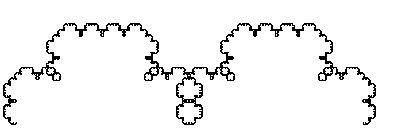Typeset your answers neatly and submit a hardcopy solution at the beginning of class on 2012-03-27. You should consider using LaTeX, but I will not force you to do so.
Please note that many of these questions are not answerable solely from the course notes and textbooks. You may actually need to do some research—the web is fine. Remember to cite your sources. Also note that just because you pull data from a reputable source doesn't mean your answer will be good enough for full credit, let alone correct. Make sure your response answers the question, and answers it thoroughly. But be brief!
- The following recursive figure is made up of four copies of itself. Circle them.

- What is the significance of a long genotype? Of a prosaic isomorphism?
- What logical rule of inference is the Tortoise refusing to employ in Chromatic Fantasy and Feud?
- Prove the following theorems of the Propositional Calculus (you
can use any reasonable formulation of the calculus — just state
which one you are using). Also, give the translation of each formula
into English, assuming p stands for "This mind is Buddha" and
q stands for "The moon is shining on the lake."
<p ⊃ <q ⊃ p>><p ⊃ <q ∨ ~q>><<p ∧ ~p> ⊃ q><<p ∧ ~p> ⊃ ~q><<p ⊃ q> ∨ <~q ∧ p>>
- Express the following in TNT notation:
- 8 is not the square of 3.
- 8 is not the square of any number.
- 53 is odd.
- Multiplying a number by 1 gives you that number.
- There are infinitely many prime numbers.
- Every number has a successor.
- There is a least number.
- Every even prime is the sum of two numbers.
- Every even number is the sum of two primes.
- There is a number n such that 3n+1 is prime.
- (EXTRA CREDIT) There are no solutions to an + bn = cn
- Read five koans from The Gateless Gate. For each, identify which aspect of your consciousness causes an obstacle to enlightenment. Is this act of analysis something a student of Zen would normally undertake? Why or why not?
- For each of the following questions, explain whether the answer "Mu"
(or "Wu" (無)) is appropriate, and why:
- Are you still beating your wife?
- Is the proposition "this sentence is true" true?
- Who is the King of France?
- Where did you hide the murder weapon?
- Has a dog Buddha-nature or not?
- In A Mu Offering, what aspect of formal systems underlies the Tortoise's question of whether it is possible to make strings that don't have Buddha-nature? What aspect underlies his question of whether certain strings with Buddha-nature cannot be made by following the Rules of Zen strings?
- (This question is asked but not answered by Hofstadter himself.) What would it have meant, and would it have made any difference, if Nansen's response to a monk's question of whether there exists a teaching that no master ever taught before were "no" instead of "yes"?
- Consider this quote from GEB: "[The] master wants to get across the idea that an enlightened state is one where the borderlines between the self and the rest of the universe are dissolved." Is such a state possible? Does the fact that we can describe or imagine such a state (using words!) have anything to do with this question? Consider Jill Bolte Taylor's experience in this video in your answer.